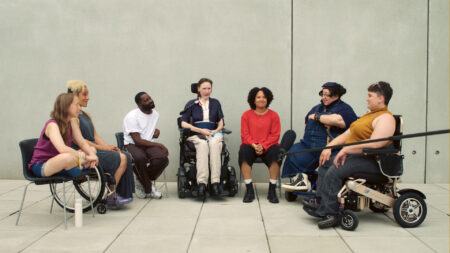Continue playing
(Time remaining: )
Play from beginning
Continue playing "{{ controller.videos[controller.getVideo(controller.currentVideo)].segmentParentTitle}}"
{{controller.videos[controller.getVideo(controller.currentVideo)].title}} has ended.
Become Your Own NavigatorOlafur Eliasson
One of five new films from Art21’s spring/summer 2019 programming
Working with elements such as light, color, and reflection, artist Olafur Eliasson invites viewers to project their own subjective context onto the reading of his artwork. Eliasson attributes this approach to his childhood experiences traveling through the Icelandic landscape and his discovery of Light and Space movement artists like James Turrell and Robert Irwin during art school. For Eliasson, both experiences encouraged him to think about the relationship between space and movement—the agency of the viewer and the responsibility of the artist.
On site for an exhibition at Tanya Bonakdar Gallery in New York, Eliasson describes how his installation, The listening dimension (orbit 1, orbit 2, and orbit 3) (2017), appears to hover in space, addressing a notion of perceived elitism in art. Viewers are able to look behind each installation to see the mechanics of how this optical illusion is created. “The abstraction allows for you to find out for yourself, and I find that very generous and also very trust-generating,” says Eliasson.
Back at work in his Berlin studio, Eliasson explains that he doesn’t consider his own experiences central to his artwork. Through colorful installations such as Your rainbow panorama (2006–2011) at ARoS Aarhus Kunstmuseum and Reality projector (2018) at Marciano Art Foundation, the artist instead encourages the public to move through space, become enveloped in light and color, and experience their own emotional journey. “Everybody has a relationship with natural phenomena,” declares Eliasson. “You don’t have to be a professional to have an opinion about a rainbow. I’ve been quite busy in my artworks saying ‘well it’s not about me growing up in nature, it’s really about you and what you can make of it.'”
Credits
Producer: Ian Forster, Rafael Salazar, and Ava Wiland. Interview: Nick Ravich and Ava Wiland. Editor: Morgan Riles. Camera: Christoph Lerch, Rafael Salazar, and Marc Levy. Sound: Rasmus Damsgaard. Colorist: Jonah Greenstein. Artwork Courtesy: Olafur Eliasson, Tanya Bonakdar Gallery, and James Turrell. Archival Footage Courtesy: Studio Olafur Eliasson. Music: Adi Goldstein.
Artworks:
“Colour experiment no. 78” (2015)
“The Domadalur daylight series (north)” (2006)
“The green river series” (1998)
“The landscape series” (1997)
“The listening dimension (orbit 1, orbit 2, and orbit 3)” (2017)
“Rainbow bridge” (2017)
“Reality projector” (2018)
“Space resonates regardless of our presence (Monday–Wednesday)” (2017)
“Sphere” (2003)
“Your rainbow panorama” (2006–2011)
Extended Play is supported by The Andy Warhol Foundation for the Arts; and, in part, by public funds from the New York City Department of Cultural Affairs in partnership with the City Council; the Art21 Contemporary Council; and by individual contributors.
Closed captionsAvailable in English, German, Romanian, Italian, Japanese, Korean, Chinese, Italian
Through the Art21 Translation Project, multilingual audiences from around the globe can contribute translations, making Art21 films more accessible worldwide. Translate this video now.
Interested in showing this film in an exhibition or public screening? To license this video please visit Licensing & Reproduction.
Olafur Eliasson was born in Copenhagen, Denmark, in 1967. Moving seamlessly from his early photographs to sculpture, immersive environments, large-scale public interventions, and architectural projects, Eliasson uses simple natural elements—light, color, water, and movement—to alter viewers’ sensory perceptions. Predicated on the idea that “art does not end where the real world begins,” Eliasson’s work lives in the active exchange between his creations and the viewers.
“Everybody has a relationship with natural phenomena. You don’t have to be a professional to have an opinion about a rainbow.”
Olafur Eliasson

